WINTER 2024 Seminars
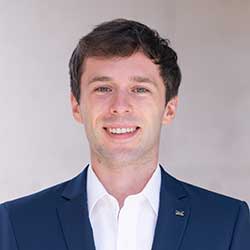
January 25, 2024
Daniel Floryan
Kalsi Assistant Professor, University of Houston
The unsteady aerodynamics of bio-inspired locomotion
Abstract:
Human flight arose because of our persistent fascination with the flight of birds. Flying and swimming animals continue to be a source of inspiration for engineers as we seek better and more robust ways to traverse, monitor, and explore the world’s skies and waters. In this talk, I will home in on a particular curiosity of biolocomotion: that a great variety of birds, bats, insects, and fish all move the same way. I will explain in what way they are the same, and how unsteady aerodynamics has created evolutionary pressure to make them the same. Finally, I will conclude with a short discussion of related open problems where we stand to learn much from biology.
Bio:
Daniel Floryan is the Kalsi Assistant Professor of Mechanical Engineering at the University of Houston. He received his B.S. in mechanical engineering and B.A. in economics from Cornell University, and his M.A. and Ph.D. in mechanical and aerospace engineering from Princeton University, where he graduated as the Porter Ogden Jacobus Fellow. Before joining the University of Houston, he was a postdoc at the University of Wisconsin-Madison. His research interests lie at the intersection of fluid mechanics and nonlinear dynamics.
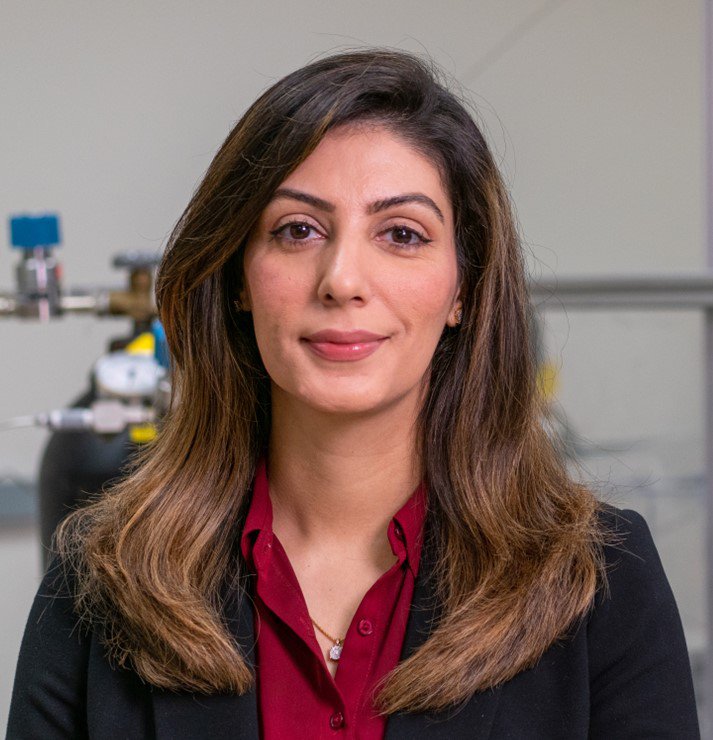
February 1, 2024
Dorrin Jarrahbashi
Assistant Professor, University of Texas A&M
Multiphase Flow Behavior at Extreme Conditions in Emerging High-Speed Aerospace Technologies
Abstract:
Commercializing future hypersonic aerospace technologies demands the design of advanced high-speed liquid-fueled propulsion systems and robust vehicle structures capable of withstanding the impact of hydrometeors during atmospheric re-entry. The imperative to achieve net-zero carbon emissions in U.S. aviation by 2050 prompts inquiries into the performance of scramjets and rotating/pulsed detonation engines using Sustainable Aviation Fuels (SAF). To meet these demands, this presentation contributes to understanding shock-driven multiphase breakup and mixing, ranging from shock interaction with fuel sprays in high-pressure combustors to the interaction of the shocked flowfield around hypersonic vehicles with a cloud of rain droplets. Shock-driven breakup and mixing is governed by several concurrent interfacial processes occurring over a wide range of length and time scales, baffling experimental and computational methods. This presentation introduces a new computational framework integrating Molecular Dynamics and Direct Numerical Simulations to elucidate the mechanisms underlying shock-driven droplet breakup when exceeding the critical point, i.e., supercritical conditions, spanning from molecular-level interfacial interactions to higher scales. The results reveal unique shock dynamics and breakup regimes not observed at subcritical conditions. This knowledge significantly enhances our understanding of supercritical fuel/air mixing, vital for achieving more stable combustion processes in next-generation high-speed propulsion systems operating with SAF. Furthermore, this presentation provides an understanding of the mutual interaction between a cloud of particles and the transient, vehicle-induced shocked flowfield around hypersonic vehicles. This computational analysis is of paramount importance for precisely predicting surface impact—an essential factor in developing material damage models necessary for the design of future hypersonic vessels.
Bio:
Dorrin Jarrahbashi is an Assistant Professor at the J. Mike Walker ’66 Department of Mechanical Engineering and Aerospace Engineering Department at Texas A&M University. She completed her post-doctoral studies at Georgia Institute of Technology and received her PhD in Mechanical & Aerospace Engineering from University of California, Irvine, and her MS from Sharif University of Technology. She is the recipient of NSF CAREER Award from the Fluid Dynamics Program, the American Physical Society-Division of Fluid Dynamics Gallery of Fluid Motion award, and the Society of Women Engineers Fellowship. Her research focuses on developing computational models to understand reacting and non-reacting multiphase flow behavior and developing novel nanoparticle spray deposition techniques assisted by supercritical flows. She currently leads projects supported by NSF, Office of Naval Research, and industry and has published her work in Nature, Fuel, Combustion & Flame, and Journal of Fluid Mechanics, featuring on the journal cover.
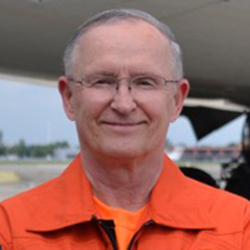
February 8, 2024
Terry Lutz
Test Pilot
Explaining and Accurate Pressure-Derived AOA with Practical Application
Abstract:
Prof Dave Rogers of the US Naval Academy postulated that the basic equations for coefficient of lift can identify 4 specific points to map a curve comparing differential pressure with angle of attack (AOA). A highly accurate curve can be produced with dynamic testing and data collection at 50 hz. This paper compares YAPS test boom data, GNSS/INS data, and differential pressure to determine the accuracy and transient response of pressure-derived AOA. With high confidence in the data, pressure-derived AOA can serve to provide both energy awareness and stall warning to reduce the risk of loss of control accidents with general aviation aircraft. There is an AOA that correlates with 0 PS for real-time thrust/drag ratio at current power setting, gross weight, and G. This cue also correlates with optimum approach AOA, providing a single easy to recognize “on speed” condition. Loss of power during initial climb carries a high fatality risk if the decision to attempt a turn-back is made. Knowledge of energy state is essential. Engine off testing was performed to determine residual thrust compared to an idling engine. This knowledge was used to develop an iPhone-based application that accurately calculates the proper altitude to perform a turnback maneuver after engine failure during initial climb. The app updates ambient data at 1 hz to accurately alert the pilot. Turnback maneuvers were performed with only pressure-derived AOA as the primary reference during beta testing of the app.
Bio:
Terry was a USAF fighter pilot having flown the F-4 Phantom II, A-10, and F-16 operationally. He has a degree in Aero Engineering from the University of Michigan, and used that expertise while assigned to the F-16 Program Office during Full Scale Development. He attended the USAF Test Pilot School and served there as an instructor pilot. Prior to becoming an airline pilot, he flew as an instructor pilot for Calspan, flying the variable-stability Learjet and NT-33A. Terry evaluated all the new FBW transport aircraft coming into commercial service, which led to becoming an experimental test pilot for Airbus in Toulouse, France. He has extensive experimental, developmental, and production flight test experience with all Airbus models, including the A-380 and A-400M. Testing included flight controls, stalls, braking, natural icing, sharklets, and numerous other tests required for certification. Terry was Captain for first flight of the Trent XWB-79 rated at 78,900 lbs thrust mounted on the No. 2 pylon of an A-380 configured as a flying test bed. The first flight took the engine to full A380 flight envelope limits, including flutter testing at the Vmo/Mmo intersection. Terry is a Fellow in the Society of Experimental Test Pilots and Member in the Society of Flight Test Engineers.
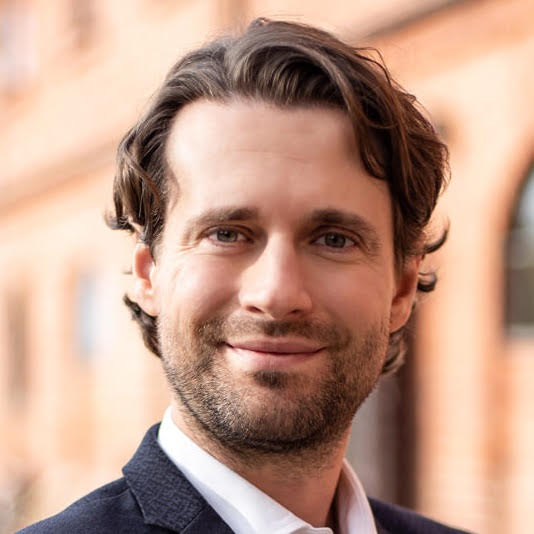
February 15, 2024
Ricardo Vinuesa
Associate Professor, KTH Royal Institute of Technology
Explaining and controlling turbulent flows through deep learning
Abstract:
In this presentation, we first use a framework for deep-learning explainability to identify the most important Reynolds-stress (Q) events in a turbulent channel (simulated via DNS) and a turbulent boundary layer (obtained experimentally). This objective way to assess importance reveals that the most important Q events are not the ones with the highest Reynolds shear stress. This framework is also used to identify completely new coherent structures, and we find that the most important coherent regions in the flow only have an overlap of 70% with the classical Q events. In the second part of the presentation we use deep reinforcement learning (DRL) to discover completely new strategies of active flow control. We show that DRL applied to a blowing-and-suction scheme significantly outperforms the classical opposition control in a turbulent channel: while the former yields 30% drag reduction, the latter only 20%. We conclude that DRL has tremendous potential for drag reduction in a wide range of complex turbulent-flow configurations.
Bio:
Dr. Ricardo Vinuesa is an Associate Professor at the Department of Engineering Mechanics, KTH Royal Institute of Technology in Stockholm. He is also Vice Director of the KTH Digitalization Platform and Lead Faculty at the KTH Climate Action Centre. He studied Mechanical Engineering at the Polytechnic University of Valencia (Spain), and he received his PhD in Mechanical and Aerospace Engineering from the Illinois Institute of Technology in Chicago. His research combines numerical simulations and data-driven methods to understand, control and predict complex wall-bounded turbulent flows, such as the boundary layers developing around wings and urban environments. Dr. Vinuesa has received, among others, an ERC Consolidator Grant (the most prestigious research program in Europe), the TSFP Kasagi Award, the Goran Gustafsson Award for Young Researchers, the IIT Outstanding Young Alumnus Award, the SARES Young Researcher Award and he leads several large Horizon Europe projects adding up to around 15M€. He is also a member of the Young Academy of Science of Spain.
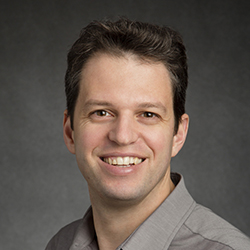
March 7, 2024
Marco Panesi
Professor, University of Illinois at Urbana Champaign
A Novel Hydrodynamic Non-Equilibrium Model for Hypersonic Flows
Abstract:
The simulation of the aerothermal environment surrounding vehicles moving at hypersonic speed is a complex problem due to its multi-physics and multi-scale nature. Progress in the ability to accurately model these systems has been hindered by the lack of reliable physical models for the thermochemical and transport processes that dominate the dynamics of the flow. The most physically consistent description of non-equilibrium flows relies on the direct numerical solution of the kinetic equations for each internal state of the gas particles. However, for problems of interest, the exponentially large number of degrees of freedom and the wide range of spatial and temporal scales involved make these equations unsolvable. This talk outlines a new paradigm for constructing predictive modeling and simulation tools from a fundamental physics perspective, rejecting the empiricism that has prevented progress in modeling hypersonic flows for decades. I will delve into the critical aspects of model development, including: (1) the use of direct numerical simulation to understand the fundamental physics; (2) the derivation of a reduced-order set of equations that provide an accurate and physically consistent description of the physics, while significantly reducing computational cost; (3) validation and uncertainty quantification.
Bio:
Dr. Marco Panesi is the Director and Founder of the Center for Hypersonics and Entry Systems Studies(CHESS) at the Grainger College of Engineering, University of Illinois at Urbana-Champaign. He also serves as a Professor in the Department of Aerospace Engineering. Dr. Panesi received his Ph.D. in 2009 from the von Karman Institute for Fluid Dynamics in hypersonics and Plasma Physics. He then completed post-doctoral research at the PECOS center at Oden’s Institute. In 2012, he joined the faculty at the University of Illinois as an assistant professor and was promoted to Professor in 2022. Dr. Panesi has won several awards, including the Vannevar Bush Faculty Fellowship, the Young Investigator Program award from AFOSR, and the Early Career Faculty award from NASA. He has won Best Paper/Presentation Awards at AIAA conferences several times. In 2015, he received the Award on Physical Modelling at the Symposium on Aerothermodynamics for Space Vehicles (ESA) for his contribution to the fundamentals of Aerothermodynamics.
Fall 2023 Seminars
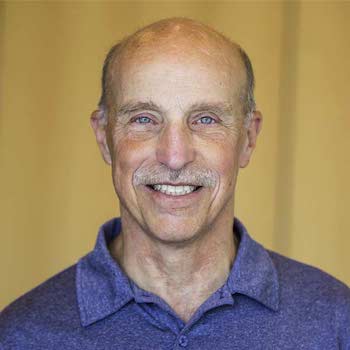
September 8, 2023
Jim Bagian
Professor University of Michigan
Lessons From Challenger and Columbia
Abstract:
Spaceflight operations can be unforgiving of systems performance that does not stay within planned limits. This lecture will discuss the Space Shuttle Program and the factors influencing decisions that were made with regard to mitigating the risks to crew survival in the event of a catastrophic failure of the Space Shuttle. The decisions and capabilities for crew survival covering the period from initial Shuttle design and atmospheric testing in the 70’s through the final Shuttle flight on Atlantis, STS-135, in 2011 with particular emphasis on the Challenger and Columbia mishaps will be discussed.
Bio:
Jim Bagian is a Professor in the College of Engineering, Department of Anesthesiology and the Executive Director of the Center for Risk Analysis Informed Decision Engineering at the University of Michigan. He has extensive experience in the fields of human factors, aviation, and patient safety.
A NASA astronaut for over 15 years, he is a veteran of two Space Shuttle missions including as the lead mission specialist for the first dedicated Life Sciences Spacelab mission. Following the 1986 Challenger space-shuttle mishap he served as an investigator and dove and supervised the capsule and crew recovery from the ocean floor. After the Challenger mishap Bagian was one of the leads for the development and implementation of the Space Shuttle escape system that was implemented after the Challenger mishap. He subsequently served as the Chief Flight Surgeon and Medical Consultant for the Space Shuttle Columbia Accident Investigation Board in 2003.
Dr. Bagian holds a B.S. degree in mechanical engineering from Drexel University and a doctorate in medicine from Thomas Jefferson University. He is a Fellow of the Aerospace Medical Association and an elected member of the National Academy of Engineering and the National Academy of Medicine.
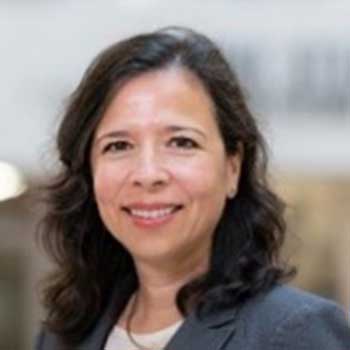
September 14, 2023
Ivett Leyva
Department Head and Professor
Morphable IntelligOverview of the Aerospace Engineering Department at Texas A&M and Finding the Origin of Heat Streaks on Hypersonic Canonical Geometriesent Space Structures
Abstract:
This talk will start with an overview of the Aerospace Engineering Department at Texas A&M. The department’s faculty, research areas, steady growth and student trends will be covered.
Then, a recent area of my research will be discussed. In the last decade, there have been observations of heat streaks on swept geometries like HiFIRE5. The observations have been numerical, experimental and in flight. The exact origin of the heat streaks has not been studied independently. It is likely that the heat streaks are a combination of factors like the geometry itself (swept), stationary cross flow, and shock curvature. In this nascent study, my team has created a swept wedge and analyzed it numerically and experimentally. The team is aiming to measure and isolate the effects of shock curvature, swept geometry, and natural instability modes on the heat streaks. The preliminary results will be discussed.
Bio:
Ivett A. Leyva became the head of the Department of Aerospace Engineering at Texas A&M University in September 2021. Previously, she worked at the Air Force for 15 years. She was the program officer for Hypersonic Aerodynamics at the Air Force Office of Scientific Research, AFRL and prior to that she was a researcher at the AFRL Rocket Lab working on liquid rocket instabilities. Her technical expertise is in hypersonic aerodynamics and liquid rocket engines. While at the Air Force Ivett also worked on the protection of basic and applied research. Ivett holds a bachelor’s, master’s and doctoral degree from Caltech. Her Ph.D. was in Aeronautics. Ivett has six patents and has authored numerous papers and two book chapters. She is a fellow of the American Institute for Aeronautics and Astronautics and the Air Force Research Laboratory, a National Associate of the National Research Council of the National Academies, and a recipient of a Civilian Achievement Medal and two meritorious Civilian Service Awards and Medals from the Air Force. Ivett has co-authored six NRC reports and was a member of the ASEB for 6 years.

September 28, 2023
Thomas H. Zurbuchen
Prof and Director of ETH Zurich|Space
Space Science and Exploration with Commercial and International Partnerships: Lessons Learned
Abstract:
Both U.S. and international space exploration and research programs are undergoing significant transformations. Rather than solely concentrating on traditional programs involving established participants, these initiatives now incorporate international and commercial partners, enabling missions previously deemed unfeasible. By examining examples from the past decade, we will explore how these novel approaches foster innovation and generate new value, while also presenting new challenges.
Bio:
Thomas Zurbuchen is the longest continually running Head of Science at NASA from 2016 to 2022. Previously Professor for Space Science and Aerospace Engineering at the University of Michigan. Also founder of the largest Entrepreneurship programme at American Universities – the Michigan Center for Entrepreneurship – and a member of the international Academy of Astronautics. Now Professor of ETH Zurich Space and leading Space Programs at ETHZ and beyond.
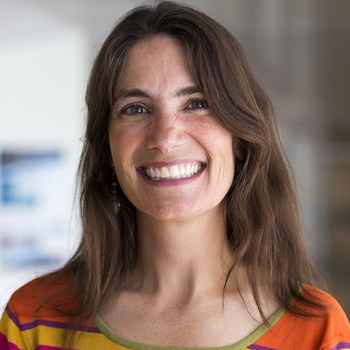
October 5, 2023
Margaret Wooldridge
Professor, Mechanical and Aerospace Engineering Departments, University of Michigan
Introducing the Institute for Energy Solutions and “Are we there yet?” A short discussion on the merits of ethanol as a transportation fuel
Abstract:
The University of Michigan recently created the Institute for Energy Solutions. The mission of the Institute is to pursue energy science and technologies to enable, accelerate and inform the transition to an equitable, resilient, clean, affordable and sustainable energy future. A brief introduction to the Institute and the new graduate student Fellows program launched this Fall 2023 semester will be presented.
In addition, the attractive combustion characteristics of ethanol as a transportation fuel will be discussed, including an introduction to some of the diverse methods used to assess alternative and sustainable fuels. Experimental results spanning a range of chemical physics show the effects of the properties of ethanol on key ignition, combustion and pollutant emission characteristics. The context and influence of policy on integration of fuels into the transportation sector will also be briefly introduced.
Bio:
Margaret Wooldridge is the Walter J. Weber, Jr. Professor of Sustainable Energy, Environmental and Earth Systems Engineering in the Departments of Mechanical Engineering and Aerospace Engineering and the Director of the Institute for Energy Solutions at the University of Michigan. She received her Ph.D. in mechanical engineering from Stanford University in 1995; her M.S.M.E. in 1991 from S.U. and her B.S. M.E. degree from the University of Illinois at Champagne/Urbana in 1989. She was on the faculty at Texas A&M University before joining the University of Michigan in 1998. Prof. Wooldridge’s research program spans diverse areas where high-temperature chemically reacting systems are critical, including power and propulsion systems, fuel chemistry, and synthesis methods for advanced nanostructured materials. She is a fellow of the American Society of Mechanical Engineers (ASME), the Combustion Institute, and of the Society of Automotive Engineers (SAE), and the recipient of numerous honors including the Department of Energy Ernest Orlando Lawrence Award

October 19, 2023
Martin N. Ross
Member of Technical Staff, The Aerospace Corporation
The Coming Surge in Spaceflight Emissions
Abstract:
Rocket launches and space debris reentries emit gases and particles into every level of the atmosphere. Until recently, spaceflight emissions were small and slow growing so that, despite large uncertainties, a reliable upper bound could be placed on their impacts to global climate and ozone. The present day space industry, however, is innovating and fast growing with reusable rockets, accelerating launch rates, large low earth orbit constellations, and increasing disposal of space debris into the atmosphere. By midcentury, the level and scope of spaceflight emissions could be comparable to aviation emissions, but with much larger uncertainties. Increasing attention to geoengineering schemes indicate that understanding every source of stratospheric aerosol affecting Earth’s radiation budget, including spaceflight, are future a research priority. While not directly affecting climate or ozone, thermosphere launch emissions cause transient ionospheric perturbations that could affect regional space weather. We review space technology trends, potential changes in emissions type and quantity, and the scientific basis to understand the space industry’s global impacts. We describe a program of plume measurements and global modeling that would close the most important knowledge gaps and provide critical information to policy makers and help create a sustainable space industry in the 21st century.
Bio:
Dr. Martin N. Ross from The Aerospace Corporation conducts research concerning climate change and the impacts of space systems on the global atmosphere. Ross works with NOAA, NASA, and other government and commercial organizations to study how rocket launches and space debris reentries affect Earth’s climate and stratospheric ozone layer. Ross contributes to international assessments of climate and ozone for the World Metrological Association and serves on advisory committees for government agencies. Ross has a B.S. in Aerospace Engineering from the University of Michigan and a Ph.D. in Planetary Physics from UCLA. He has published over 75 papers on a wide variety of subjects including climate change, space industry sustainability, planetary physics, and space policy. Ross serves as an Adjunct Professor at Embry-Riddle Aeronautical University, teaching physics, meteorology, and history of science. He is currently developing new strategies and studies to understand how the space industry can grow and innovate and in a globally sustainable manner.
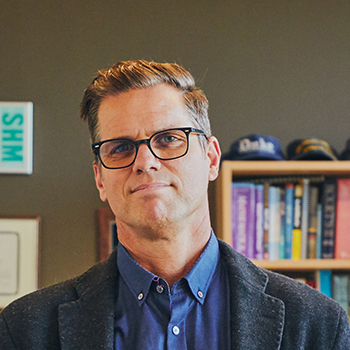
October 26, 2023
Michael Todd
Distinguished Professor and Chair, University of California San Diego
The Use of Detection Theory and Bayesian Experimental Design in Ultrasonic Structural Health Monitoring
Abstract:
Structural health monitoring (SHM) is the process of designing and using structural a monitoring strategy to inform decision-making. This presentation introduces the use of detection theory and a Bayes risk-based approach for structural health monitoring (SHM) applications. Starting from a general formulation of Bayes risk, we derive a global optimality criterion within a detection theory framework. The optimal design configuration is then established as the one that minimizes the total computed Bayes Risk (or loss) for the application. While the approach is suitable for many sensing/actuation SHM processes, we focus on the example of active sensing using guided ultrasonic waves by implementing an appropriate general statistical model of the wave propagation and feature extraction process. This example implements both pulse-echo and pitch-catch actuation schemes and accounts for line-of-site visibility and non-uniform damage probabilities over the monitored structure. The design space considers the optimal placement and selection of transducers. We provide a few actuator/sensor placement test problems (within the separate problems of detection and localization) and discuss the optimal solutions generated by the algorithm. Such a scheme allows for proper uncertainty quantification in the design and application process of SHM solutions.
Bio:
Michael Todd received his B.S.E. (1992), M.S. (1993), and Ph.D. (1996) from Duke University’s Department of Mechanical Engineering and Materials Science. In 1996, he began as an A.S.E.E. post-doctoral fellow, then a staff research engineer (1998), and finally Section Head (2000) at the United States Naval Research Laboratory (NRL) in the Fiber Optic Smart Structures Section. In 2003, he joined the Structural Engineering Department at the University of California San Diego, where he currently serves as Professor of Structural Engineering. He has published over 450 papers and proceedings in his research areas, which are in time series modeling techniques for structural health monitoring (SHM) applications, ultrasonics, uncertainty quantification in SHM, and synthesizing digital twin structural life cycle models. Prof. Todd won the 1999 Alan Berman NRL Publication Award, the 2003 and 2004 NRL Patent Award, won the 2005 Structural Health Monitoring Person-of-the-Year Award, was named a 2009 Benjamin F. Meaker Fellow at the University of Bristol (UK), won the 2016 Society of Experimental Mechanics D. J. DeMichele Award for contributions to research and education in experimental mechanics, and won the 2021 SHM Lifetime Achievement Award. He serves as the Managing Editor of Structural Health Monitoring: An International Journal.
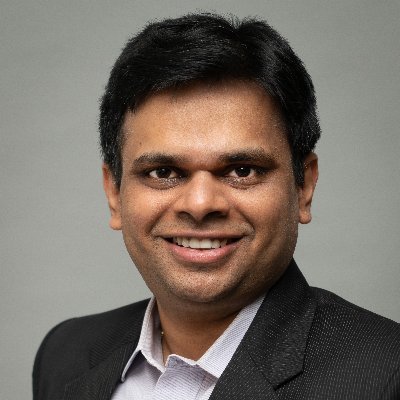
November 2, 2023
Venkat Viswanathan
Associate Professor of Aerospace Engineering, University of Michigan
Challenges and Opportunities of Battery-Powered Flight
Abstract:
Sustainable transportation and aviation are critical to address climate change and renewable energy powered battery electric vehicles represent a promising path towards this goal. We will discuss the performance metrics needed of batteries for electric land and air vehicles, and assess the energy-efficiency of electric vertical take-off and landing (eVTOL) aircraft compared to ground vehicles.[1] Identifying the challenging but achievable battery performance requirements for eVTOL, WE will discuss our approach to achieve simultaneously high specific energy and power by using lithium metal anodes, enabled through a new density-driven dendrite suppression mechanism realized through a soft polymer-ceramic composite separator[2]. We will discuss the unique performance failure mode related to power fade for eVTOLs rather than energy fade for electric vehicles. Following this, we will discuss the requirements and challenges for all-electric battery-powered single and twin-aisle aircraft and outline battery chemistry innovations that offer a pathway to approaching these requirements.[3] We will discuss two key tools to accelerate the innovation timeline for these battery chemistries: (i) in-situ and operando characterization[4] (ii) closed-loop battery material discovery with physics based simulation and robotic experimentation.[5]
References: [1] Sripad, Viswanathan, Proceedings of the National Academy of Sciences 9, 2021 118 (45) e2111164118 [2] Fu et al., Nature Materials, (2020), 19, 758–766. [3] Viswanathan et al., Nature, 601, 519–525 (2022), [4] Hafiz et al., Nature, 594, 213–216 (2021) [5] Dave et al., Nature Communications, 13, 5454 (2022).
Bio:
Venkat Viswanathan leads an interdisciplinary group comprising of ~30 researchers working on technologies that can accelerate the transition to sustainable transportation and aviation. He is a recipient of numerous awards including the MIT Technology Review Innovators Under 35, Office of Naval Research (ONR) Young Investigator Award, Alfred P. Sloan Research Fellowship in Chemistry and National Science Foundation CAREER award. He is the co-founder of several startups, Aionics, Chement and And Battery Aero.
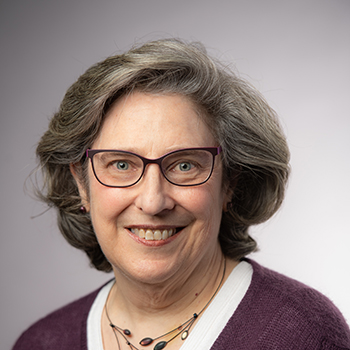
November 9, 2023
Sharon Swartz
Professor, Department of Ecology, Evolution, and Organismal Biology and School of Engineering, Brown University
Bat Wings are Multifunctional: Actuation, Sensing, and Thermoregulation in a Flapping Wing
Abstract:
The wings of bats are extraordinary structures that support a landmark capability of only one group of mammals: powered, flapping flight. Accordingly, much more research has been devoted to how bat wings generate flight forces than to other ways that wings contribute to flight performance. I’ll discuss how a broader and more integrative appreciation of wing structure and function will enhance understanding of bat flight. I’ll examine three factors that could contribute to a more holistic understanding of bat wings. First, I’ll show that bat wings have the capacity to robustly reject substantial perturbations and to enact complex low-speed maneuvers, and that this depends on their function as inertial appendages, distinct from their aerodynamics. Second, along with typical mammal sensory apparatus, bat wings possess a unique sensory hair network whose function remains uncertain. Third, wings operate well below core body temperature during flight, although high levels of muscle performance in cold tissue require adaptations at multiple levels. Traits that improve inertial dynamics differ from those that augment aerodynamic performance; understanding of sensory hair networks has barely been initiated; and wing muscle physiology is only beginning to be explored. Research that integrates these factors will improve our ability to uncover how bats acquired their flight abilities and has the potential to inspire novel designs.
Bio:
Sharon Swartz is Professor of Ecology, Evolution, & Organismal Biology and Engineering. She received her B.A. in Biology (High Honors) from Oberlin College (1981), and her M. S. (1986) and Ph. D. (1988) from the Committee on Evolutionary Biology of The University of Chicago. She joined the faculty at Northwestern University in 1987. In 1990, she became an Assistant Professor in the Department of Ecology, Evolution, and Organismal Biology and the School of Engineering at Brown University, where she has been Professor since 2009.
Professor Swartz’ primary research interests are in comparative biomechanics and locomotion, particularly animal flight. She aims to understand how the constituents of wings – bone, tendon, muscle, skin, and hair – are modified for the mechanical and aerodynamic demands of flight performance. Her recent work focuses on sensorimotor integration and the role of hair sensors in bat motor control. To carry out this work, she integrates traditional and contemporary biological methods for studying animal structure with engineering concepts and approaches, to answer functional, evolutionary, and ecological questions. Her well-funded research program has over one publications. She has served as chair of the Division of Comparative Biomechanics of the Society for Integrative and Comparative Biology and Program Director for the Physiological Mechanisms and Biomechanics Program at the National Science Foundation. Her honors include Fellowship in the AAAS; Brown University’s Romer Prize, the institution’s highest award for undergraduate mentoring; and the University of Chicago Distinguished Service Award for outstanding leadership and significant research in the biological sciences.

November 16, 2023
Haithem Taha
Associate Professor, University of California, Irvine
A Variational Theory of Aero-hydrodynamics
Abstract:
The Euler equation does not possess a unique solution for the flow over a two-dimensional object. This problem has serious repercussions in aerodynamics; it implies that the inviscid aero-hydrodynamic lift force over a two-dimensional object cannot be determined from first principles; a closure condition must be provided. The Kutta condition has been ubiquitously considered for such a closure in the literature, even in cases where it is not applicable (e.g. unsteady). In this talk, I will present a special variational principle that we revived from the history of analytical mechanics: Hertz’ principle of least curvature. Using this principle, we developed a novel variational formulation of Euler’s dynamics of ideal fluids that is fundamentally different from the previously developed variational formulations based on Hamilton’s principle of least action. Applying this new variational formulation to the century-old problem of the ideal flow over an airfoil, we developed a general (dynamical) closure condition that is, unlike the Kutta condition, derived from first principles. In contrast to the classical theory, the proposed variational theory is not confined to sharp edged airfoils; i.e., it allows, for the first time, theoretical computation of lift over arbitrarily smooth shapes, thereby generalizing the century-old lift theory of Kutta and Zhukovsky. Moreover, the new variational condition reduces to the Kutta condition in the special case of a sharp-edged airfoil, which challenges the widely accepted wisdom about the viscous nature of the Kutta condition.
We also generalized this variational principle to Navier-Stokes’ via Gauss’ principle of least constraint, thereby discovering the fundamental quantity that Nature minimizes in every incompressible flow. We proved that the magnitude of the pressure gradient over the field is minimum at every instant! We call it the Principle of Minimum Pressure Gradient (PMPG). We proved that the Navier-Stokes’ equation is the necessary condition for minimizing the pressure gradient subject to the continuity constraint. Hence, the PMPG turns any fluid mechanics problem into a minimization one where fluid mechanicians need not to apply Navier-Stokes’ equations, but merely need to minimize the proposed action.
Bio:
Haithem Taha is currently an associate professor in the department of Mechanical and Aerospace Engineering at the University of California, Irvine. He holds BSc and MSc degrees in aerospace engineering from Cairo University, Egypt in 2005 and 2008. He received his PhD degree from the Engineering Science and Mechanics department at Virginia Tech under the Benjamin Franklin Medalist, Prof. Ali Nayfeh, simultaneously with an MSc degree in Mathematics in Dec 2013. Taha’s research interests span geometric nonlinear control theory, unsteady aerodynamics, theoretical mechanics and variational principles with applications to unconventional flight mechanics such as bio-inspired flight. He is a Recipient of the NSF CAREER Award among several other awards. He is an AIAA Associate Fellow. Taha is particularly interested in the history and philosophy of mechanics and has several lectures on the topic.
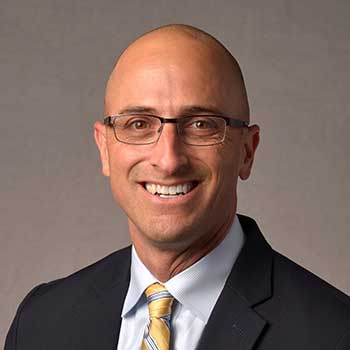
November 30, 2023
Jason Thomas
Lead – Flight Engineering, Joby Aviation
eVTOL Revolution: Innovation and Challenges
Abstract:
eVTOL aircraft represent a nascent but intriguing future aircraft segment that can both revolutionize logistics and travel, while also offering new and novel solutions or options to existing engineering and environmental problems. Independent of potential environmental benefits, this technology has the potential to greatly improve performance in several areas such as noise, safety, reliability, and utility, but also include novel engineering challenges that current and future engineers should consider. This talk will provide an overview of this industry, benefits of electric propulsion and eVTOL in particular, with focus on external loads, rotordynamic and aeroelastic challenges.
Bio:
Mr. Thomas is the Lead of Flight Engineering at Joby Aviation, joining Joby in early 2021 and has been leading certification efforts of the Joby S4 for aerodynamics, performance, aeroacoustics, external loads, rotordynamics, aeroelasticity, vibration and internal acoustics/NVH. He has been working in the aircraft industry for over 25 years, having also worked for Gulfstream, Boeing/Aurora, Northrop Grumman, Honda Aircraft, Textron/AAI and Delta Airlines. Over a 13 year period at Gulfstream, he supported structural design, loads and aeroelasticity development efforts for the G450, G500, G550, G600 and G650 aircraft, including two Collier Trophy award programs, culminating in Lead / Group Head positions within Loads and Flutter. While at Honda Aircraft, he was the Sr Manager / Lead for Loads, Flutter, Mass Properties, and Acoustics for the HA-420 and HA-420 Elite programs.
Mr. Thomas is a 2007 MSAE graduate of the University of Michigan, focusing on structural dynamics and aeroelasticity. He is also a FAA Consultant DER (Designated Engineering Representative) for External Loads, Flutter and Ground Vibration Testing (GVT), and active within ASTM F44 Certification Design standards subcommittee related to FAA aircraft/eVTOL certification standards, in addition to being a FAA-certified Flight Instructor and Commercial pilot with over 1500 flight hours.